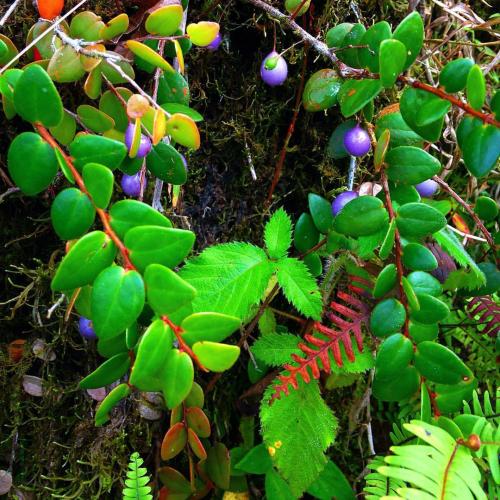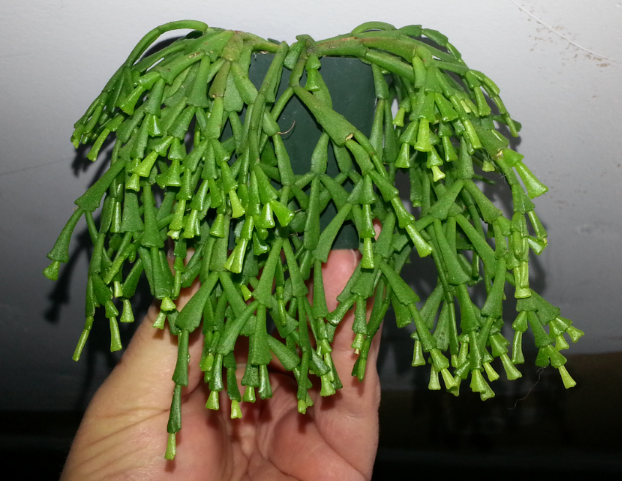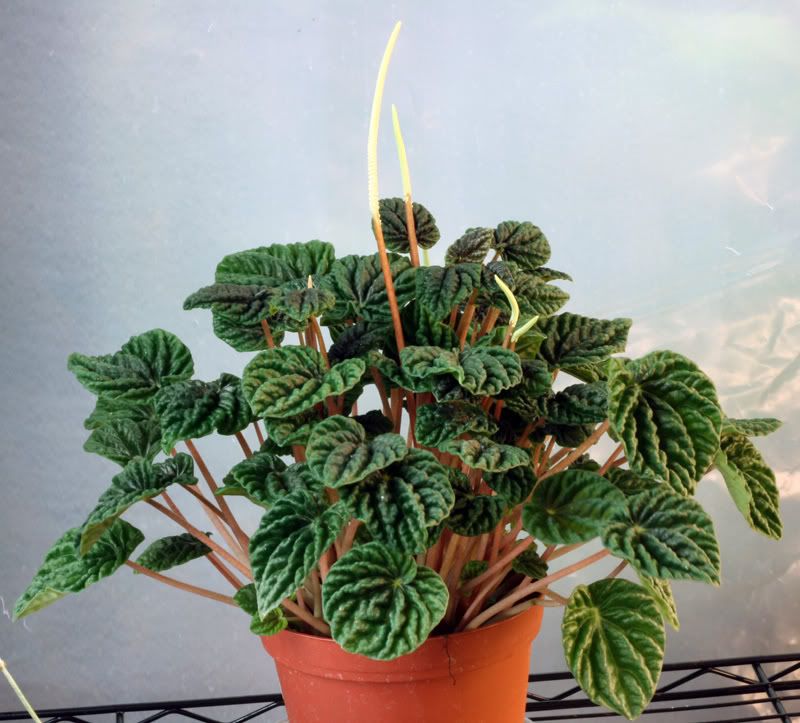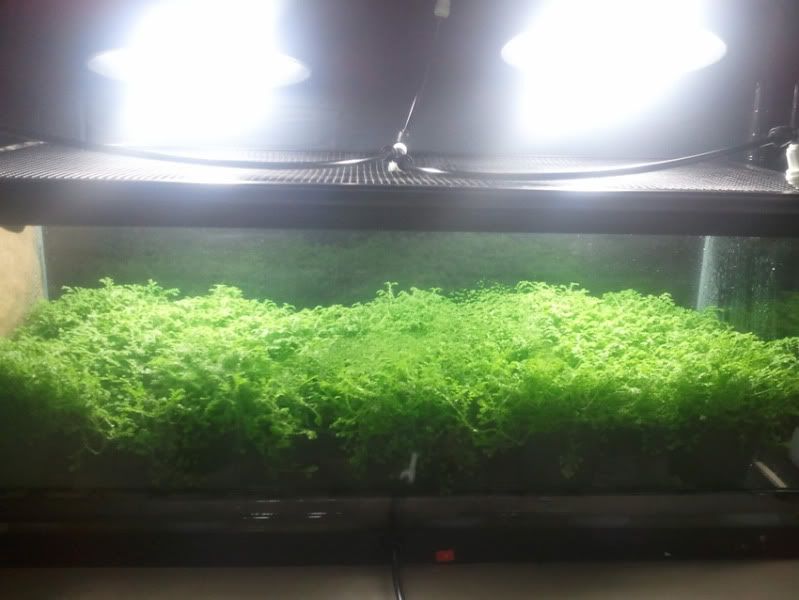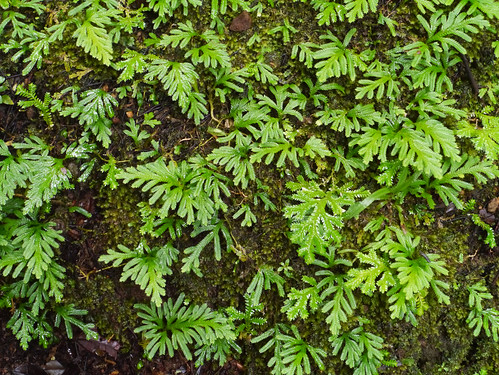Welcome to this bank of plant information, my hope is that it offers some perspective that helps improve the hobby. If you are going to contribute, please read the text carefully. If this endeavor is successful, vol 2 will be forthcoming, since the primary reason for vol 1 is to set the stage for further discussions. Although plant selection seems like a backwards presentation with regards to designing a vivarium, I think that its importance as a pivotal design aspect cannot be discounted. Put simply, no matter what the rest of your vivarium looks like, the plants will make it sing and highlight it or run it over like roadkill - only two things will make the difference, your choices early on and a good pair of scissors.
This is not meant to overturn anyone's idea of what makes a vivarium look great, and this thread is not a search for the one and only way to skin this cat. This is just an effort to help those who are striving for something they can be proud of and enjoy, and would like to talk about, or read about, how to get there. Give me one good reason why a vivarium shouldn't be awesome.
Since vivarium design is really a vast subject that can go all sorts of places, I was thinking it would be nice to get a discussion going regarding planting. There are tons of plants and plenty of vivarium styles. We've all seen the variability in different types of newly planted and long term vivariums, and there have been discussions about which specific plants to use and how to care for them. But what is the purpose in planting a vivarium? Some logical answers: with respect to the mission of most members here, to provide habitat for poison dart frogs, some are 'necessary' for reproduction (bromeliads and broadleaved plants), some for visual barriers to provide the inhabitants relief from the potential stresses caused by permanent cohabitation with tankmates. But all of those needs can be met with manufactured items, wood, and some leaf litter - no plants necessary. Then there are the aesthetics of the plants selected, on their own merit and in concert with each other, the sum of which can generate a naturalistic display that is also a functional playground for the inhabitants.
The big question is, how does plant selection relate to vivarium design? Well, when you chose your building materials and envision the finished product, you are making choices that will hopefully meet your goals. When you are selecting plants, the principle is the same, but it is actually, in my opinion, vastly more important. First, you will want to make the selections suitable for the inhabitants. Second, you may have a grand background or buttress or rock wall, etc. in mind and the last thing you imagine is seeing that good work swallowed up by creeping fig and 10 bromeliads. So, there is the long term affect of the plant choices to bare in mind. Third, you want to be able to understand how the overall appearance will take shape, from the beginning through months or years after planting. Fourth, maintenance is fun for some and a chore for others, so knowing how much trimming, if any, is involved in keeping your vivarium in order (if you desire it) will save you some trouble down the road. The last three points are all related, with the general idea being that anticipating the growth of plants you select beforehand will better enable you to execute your idea.
Let's assume that the plant's needs can be met and their usefulness to pdfs is understood, and we'll move on to talk about: 1) growth habits of various plant types and the maintenance required, if any, 2) which plants to use for desired features from beauty to function, and 3) where to plant them for best use of their growth habits and to meet their basic needs.
So, feel free to add categories (regarding terrarium plants in context) that need to be here. And to keep the introduction more brief, we can start with a couple simple graphics that name some general plant parts, then list and describe growth habits and the types of plants that fit the descriptions. I'd like it if this could this be done simply with generalizations used as a necessity, rather than splitting the groups down into overly complicated subgroups. This could become a useful guide for how to view the tiny cutting or potted plant you intend to purchase, but an in depth biology lesson should be dealt with in another thread geared towards that level of interest. But as I mentioned, please add any related categories that are missing and please use plenty of graphics to keep it interesting, informative, and approachable. General discussion and positive thoughts on the subject are also welcome - we all stand to gain by sharing our experiences.
![Image]()
![Image]()
Want to add some info?
For the types of growth habits listed (feel free to fill in any gaps), it would be nice to include some general types and species that illustrate the variety within the growth habit. Instead of only very similar types, we should look at broader habits; not all rhizomatous plants grow the same way, so it would misleading to mention only Rex Begonias, but also too complicated to look at all plants with a rhizome. Text book examples are a good way to start though.
Concerning graphics, it would be great if we could use examples that show the end result, meaning we should aim to show how the plant will eventually appear as it grows over time (where possible); showing a cutting will not be as informational as showing a grown out patch or adult (if applicable) of said plant type. After all the types have been hashed out, perhaps we can try to detail plant type placement preferences.
Regarding growth rates, they are subjective to our experiences with the plants. So, keep in mind that our perspectives on this are limited to our lighting conditions and the amount of time we have grown the plants. After growing them for a few months, we kind of have an idea of how fast they grow. But if you start with a cutting that has three leaves, it will likely take a while to get going, so you'd likely have a better idea after a year or two. And that is what this is all about, planing for how the vivarium will turn out over time. Oh, and lets skip moss for now.
To Contributors: please try to include the: Type, then habit notes and experience with it, some genus and species, and some photos
Rosette:
These are plants that grow from a central axis, with the alternating leaves typically radiating in an overall circular shape. Bromeliads, many gesneriads, some carnivorous plants, like Butterwort, and some ferns are good examples. These types may spread by rhizomes or may just remain as one solitary individual. Rosette forming plants tend to require minimal maintenance, as they don't often travel far.
Butterwort:
![Image]()
Nautilocalyx pemphidius:
![Image]()
Fern sp.:
![Image]()
Vine
This habit tends to grow vertically on an upright surface or meander around at ground level, but it can usually be identified by a long stem. Generally, this type has one terminal growth tip, and does not grow straight or stand up on its own without support. Many Philodendrons, and some other aroids fit this description. Most of the shinglers also fall in here. Depending on the growth rate, this sort of plant can require regular to intermittent maintenance.
Philodendron sp.:
![Image]()
Marcgravia sp.:
![Image]()
Monstera dubia:
![Image]()
Scrambling & Rambling
This may not be a technical term, and it encompasses several types of growth habits really, and for that reason is not easy to generalize. I tend to think of many of the 'vining' peperomias in this way, since they scramble around horizontally or upwards, without a definite prefernces, unless they are trying to reach better lighting. But as they ramble around, new growth terminals also tend to branch off. Begonia glabra, Begonia maldonado, and quite a few Selaginellas are also nice examples. These plants may take a while to get established and gain momentum, but once they do, maintenance would need to be regular to extreme to keep them in check, unless your desire is a carpet of such a plant. Carpet is a loose term, since they come in all shapes and sizes. These are semi-agressive plants, generally speaking.
Begonia glabra:
![Image]()
Peperomia fagerlindii:
![Image]()
Branching & Spreading
Although these types are fairly similar to the scramblers and ramblers, they should be set apart, based on their (eventual) fast growth rate and tendency towards branching quickly and often, so that, depending on lighting conditions, they will likely form a nearly complete wall or carpet that can encompass an entire vivarium if left alone. Creeping figs and Ciscus sp. Come to mind. This sort of plant should be used by those that desire quick and easy coverage over large areas and those who don't mind keeping an eye on the other plants to ensure that they will not become choked out and starve for the lack of light. This plant has been the death of many bromeliads and other plants, so keep that in mind. Invasive is another good term.
Although there are plenty of smaller, slower, and more manageable plants that appear to fit the spreading type, like Microgramma heterophylla and many other rambling plants, due to their less threatening nature, they should be considered scramblers for the purposes of this discussion.
Creeping Fig (taken from this thread: http://www.dendroboard.com/forum/plants/72986-why-creeping-fig-bad.html ):
![Image]()
Cissus amazonica:
![Image]()
Self-heading & Non-migratory
This is a prized and rewarding growth habit for those seeking growth types that stay in one place. Bromeliads could be viewed as such, but for this discussion, the focus is on aroids, such as numerous Anthurium species, quite a few orchids, and generally epiphytic plants. Although most Syngonium don't really fit this mold, I have a species that does grow in just this fashion. Some ferns are good examples, but few neotropical species are available to the hobby. It would be nice to get a good list of these, since, other than Anthurium and Orchids, which tend to be somewhat picky about their temperature requirements (many are highland species), there aren't many of these types that are truly suitable available to the hobby. Additionally, most of the Anthuriums are too large for the tanks most of us are using, but there are a few smaller types out there. Many orchids travel by rhizomes, but for this discussion, their non-aggressive growth lands them with this bunch. The growth rate of Self-heading plants is generally slow and they don't tend to move far from where they are planted/mounted, so they are nearly maintenance free! However, they are often more difficult to obtain and grow properly in a vivarium. One great alternative that is very happy in vivariums is Philodendron 'Wend Imbe', which is a hybrid, but is readily available. It does grow more quickly if planted, so mounting it is a great way to control it's growth.
Psygmorchis pusilla:
![Image]()
Anthurium obtusum:
![Image]()
Philodendron 'Wend Imbe':
![Image]()
Rhizomatous & Sundry
Many plants fit this category, so for this thread, let's focus on types that slowly wander, often via rhizome (stem), and those that gradually spread itself (make new plants) via lateral rhizomes, etc. I would further narrow this down to plants that generally creep along and those that have a slow to medium growth rate. Good examples are some Begonias, some ferns, many gesneriads, etc. These sorts of plants do travel, and some creative new growths as they move, but generally speaking they are more manageable and require regular to infrequent trimming.
Begonia:
![Image]()
Rabbits foot fern:
![Image]()
My hope for this thread is that we won't be biting off more than we can chew. I say "we" because this broad topic really needs the collective experiences from everyone who has delved into this area themselves and come to some conclusions on the matter. It is definitely subjective. I also don't want this to turn into a place to trash talk specific plants, but if you have picked up on the theme, then you already know there is favor given here to plants that are more easily maintained and work with the intended design. Creeping fig can work with any design, but unless the design is for a carpet of fig, some religious trimming is going to be required. Saying, "gosh, that plant sucks", doesn't really bring much to the table. Most plants are neat, but some types work better for the design (whatever yours is) than others, hence the existence of this thread. If you've ever wanted to get all philosophical (not debate) about plant selection, this would be a great time to jump in.
Again, this is a simple beginning, laying the foundation for more in-depth conversations about how we can use the various growth habit types and so on. If its already time to kick it up a notch, that's fine with me.
Mike
This is not meant to overturn anyone's idea of what makes a vivarium look great, and this thread is not a search for the one and only way to skin this cat. This is just an effort to help those who are striving for something they can be proud of and enjoy, and would like to talk about, or read about, how to get there. Give me one good reason why a vivarium shouldn't be awesome.
Since vivarium design is really a vast subject that can go all sorts of places, I was thinking it would be nice to get a discussion going regarding planting. There are tons of plants and plenty of vivarium styles. We've all seen the variability in different types of newly planted and long term vivariums, and there have been discussions about which specific plants to use and how to care for them. But what is the purpose in planting a vivarium? Some logical answers: with respect to the mission of most members here, to provide habitat for poison dart frogs, some are 'necessary' for reproduction (bromeliads and broadleaved plants), some for visual barriers to provide the inhabitants relief from the potential stresses caused by permanent cohabitation with tankmates. But all of those needs can be met with manufactured items, wood, and some leaf litter - no plants necessary. Then there are the aesthetics of the plants selected, on their own merit and in concert with each other, the sum of which can generate a naturalistic display that is also a functional playground for the inhabitants.
The big question is, how does plant selection relate to vivarium design? Well, when you chose your building materials and envision the finished product, you are making choices that will hopefully meet your goals. When you are selecting plants, the principle is the same, but it is actually, in my opinion, vastly more important. First, you will want to make the selections suitable for the inhabitants. Second, you may have a grand background or buttress or rock wall, etc. in mind and the last thing you imagine is seeing that good work swallowed up by creeping fig and 10 bromeliads. So, there is the long term affect of the plant choices to bare in mind. Third, you want to be able to understand how the overall appearance will take shape, from the beginning through months or years after planting. Fourth, maintenance is fun for some and a chore for others, so knowing how much trimming, if any, is involved in keeping your vivarium in order (if you desire it) will save you some trouble down the road. The last three points are all related, with the general idea being that anticipating the growth of plants you select beforehand will better enable you to execute your idea.
Let's assume that the plant's needs can be met and their usefulness to pdfs is understood, and we'll move on to talk about: 1) growth habits of various plant types and the maintenance required, if any, 2) which plants to use for desired features from beauty to function, and 3) where to plant them for best use of their growth habits and to meet their basic needs.
So, feel free to add categories (regarding terrarium plants in context) that need to be here. And to keep the introduction more brief, we can start with a couple simple graphics that name some general plant parts, then list and describe growth habits and the types of plants that fit the descriptions. I'd like it if this could this be done simply with generalizations used as a necessity, rather than splitting the groups down into overly complicated subgroups. This could become a useful guide for how to view the tiny cutting or potted plant you intend to purchase, but an in depth biology lesson should be dealt with in another thread geared towards that level of interest. But as I mentioned, please add any related categories that are missing and please use plenty of graphics to keep it interesting, informative, and approachable. General discussion and positive thoughts on the subject are also welcome - we all stand to gain by sharing our experiences.


Want to add some info?
For the types of growth habits listed (feel free to fill in any gaps), it would be nice to include some general types and species that illustrate the variety within the growth habit. Instead of only very similar types, we should look at broader habits; not all rhizomatous plants grow the same way, so it would misleading to mention only Rex Begonias, but also too complicated to look at all plants with a rhizome. Text book examples are a good way to start though.
Concerning graphics, it would be great if we could use examples that show the end result, meaning we should aim to show how the plant will eventually appear as it grows over time (where possible); showing a cutting will not be as informational as showing a grown out patch or adult (if applicable) of said plant type. After all the types have been hashed out, perhaps we can try to detail plant type placement preferences.
Regarding growth rates, they are subjective to our experiences with the plants. So, keep in mind that our perspectives on this are limited to our lighting conditions and the amount of time we have grown the plants. After growing them for a few months, we kind of have an idea of how fast they grow. But if you start with a cutting that has three leaves, it will likely take a while to get going, so you'd likely have a better idea after a year or two. And that is what this is all about, planing for how the vivarium will turn out over time. Oh, and lets skip moss for now.
To Contributors: please try to include the: Type, then habit notes and experience with it, some genus and species, and some photos
Rosette:
These are plants that grow from a central axis, with the alternating leaves typically radiating in an overall circular shape. Bromeliads, many gesneriads, some carnivorous plants, like Butterwort, and some ferns are good examples. These types may spread by rhizomes or may just remain as one solitary individual. Rosette forming plants tend to require minimal maintenance, as they don't often travel far.
Butterwort:

Nautilocalyx pemphidius:
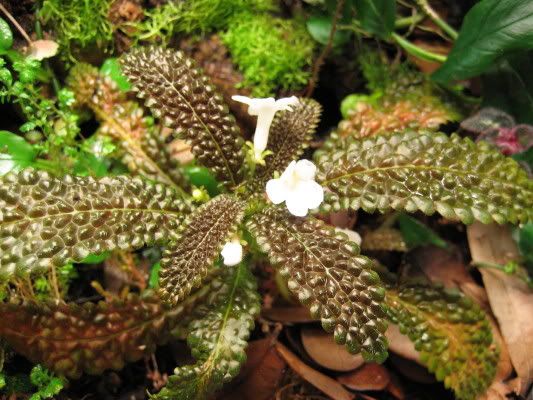
Fern sp.:

Vine
This habit tends to grow vertically on an upright surface or meander around at ground level, but it can usually be identified by a long stem. Generally, this type has one terminal growth tip, and does not grow straight or stand up on its own without support. Many Philodendrons, and some other aroids fit this description. Most of the shinglers also fall in here. Depending on the growth rate, this sort of plant can require regular to intermittent maintenance.
Philodendron sp.:

Marcgravia sp.:

Monstera dubia:
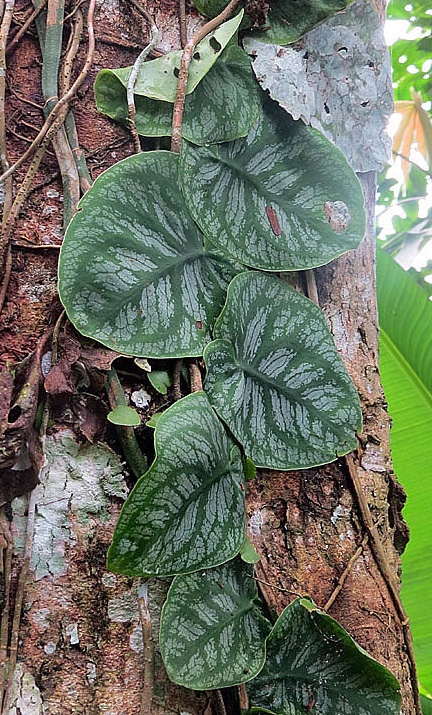
Scrambling & Rambling
This may not be a technical term, and it encompasses several types of growth habits really, and for that reason is not easy to generalize. I tend to think of many of the 'vining' peperomias in this way, since they scramble around horizontally or upwards, without a definite prefernces, unless they are trying to reach better lighting. But as they ramble around, new growth terminals also tend to branch off. Begonia glabra, Begonia maldonado, and quite a few Selaginellas are also nice examples. These plants may take a while to get established and gain momentum, but once they do, maintenance would need to be regular to extreme to keep them in check, unless your desire is a carpet of such a plant. Carpet is a loose term, since they come in all shapes and sizes. These are semi-agressive plants, generally speaking.
Begonia glabra:
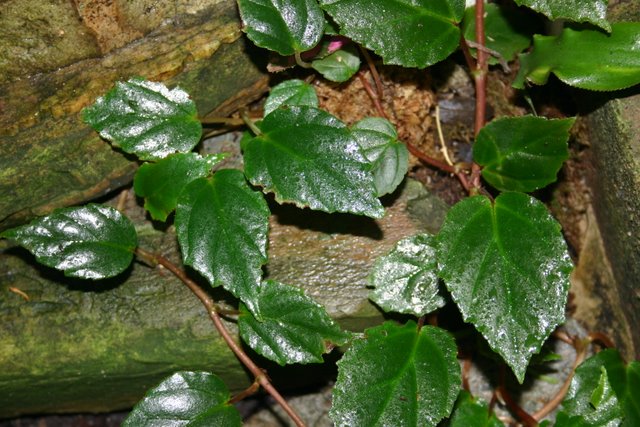
Peperomia fagerlindii:
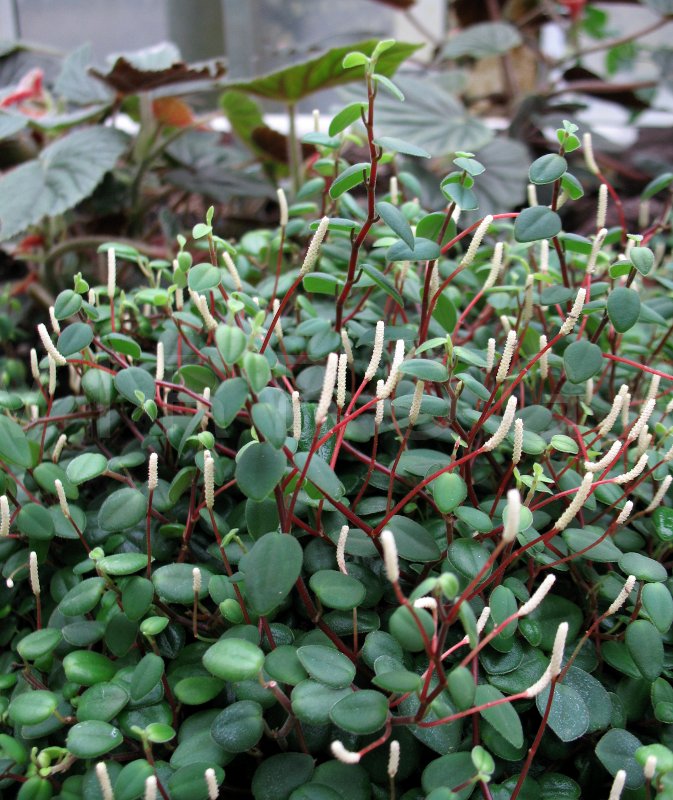
Branching & Spreading
Although these types are fairly similar to the scramblers and ramblers, they should be set apart, based on their (eventual) fast growth rate and tendency towards branching quickly and often, so that, depending on lighting conditions, they will likely form a nearly complete wall or carpet that can encompass an entire vivarium if left alone. Creeping figs and Ciscus sp. Come to mind. This sort of plant should be used by those that desire quick and easy coverage over large areas and those who don't mind keeping an eye on the other plants to ensure that they will not become choked out and starve for the lack of light. This plant has been the death of many bromeliads and other plants, so keep that in mind. Invasive is another good term.
Although there are plenty of smaller, slower, and more manageable plants that appear to fit the spreading type, like Microgramma heterophylla and many other rambling plants, due to their less threatening nature, they should be considered scramblers for the purposes of this discussion.
Creeping Fig (taken from this thread: http://www.dendroboard.com/forum/plants/72986-why-creeping-fig-bad.html ):
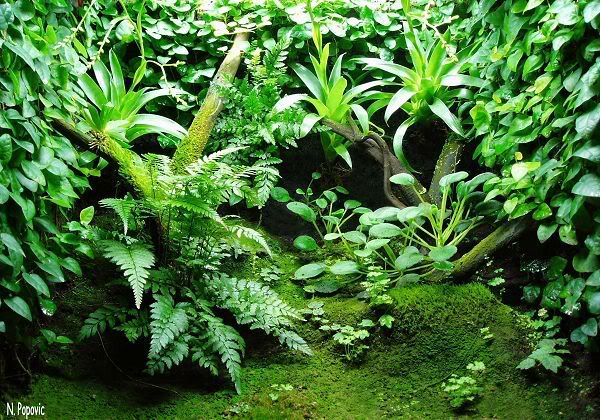
Cissus amazonica:

Self-heading & Non-migratory
This is a prized and rewarding growth habit for those seeking growth types that stay in one place. Bromeliads could be viewed as such, but for this discussion, the focus is on aroids, such as numerous Anthurium species, quite a few orchids, and generally epiphytic plants. Although most Syngonium don't really fit this mold, I have a species that does grow in just this fashion. Some ferns are good examples, but few neotropical species are available to the hobby. It would be nice to get a good list of these, since, other than Anthurium and Orchids, which tend to be somewhat picky about their temperature requirements (many are highland species), there aren't many of these types that are truly suitable available to the hobby. Additionally, most of the Anthuriums are too large for the tanks most of us are using, but there are a few smaller types out there. Many orchids travel by rhizomes, but for this discussion, their non-aggressive growth lands them with this bunch. The growth rate of Self-heading plants is generally slow and they don't tend to move far from where they are planted/mounted, so they are nearly maintenance free! However, they are often more difficult to obtain and grow properly in a vivarium. One great alternative that is very happy in vivariums is Philodendron 'Wend Imbe', which is a hybrid, but is readily available. It does grow more quickly if planted, so mounting it is a great way to control it's growth.
Psygmorchis pusilla:

Anthurium obtusum:
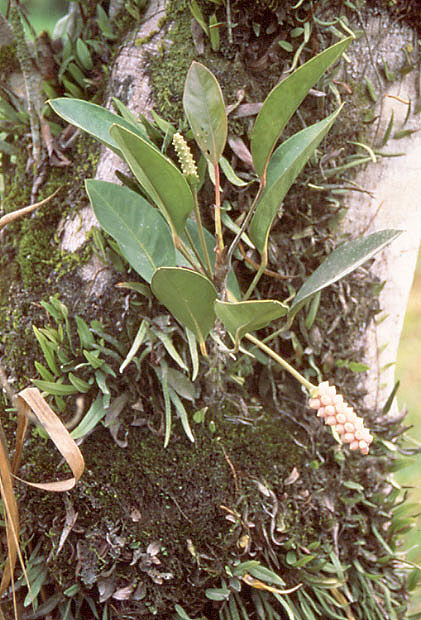
Philodendron 'Wend Imbe':

Rhizomatous & Sundry
Many plants fit this category, so for this thread, let's focus on types that slowly wander, often via rhizome (stem), and those that gradually spread itself (make new plants) via lateral rhizomes, etc. I would further narrow this down to plants that generally creep along and those that have a slow to medium growth rate. Good examples are some Begonias, some ferns, many gesneriads, etc. These sorts of plants do travel, and some creative new growths as they move, but generally speaking they are more manageable and require regular to infrequent trimming.
Begonia:

Rabbits foot fern:
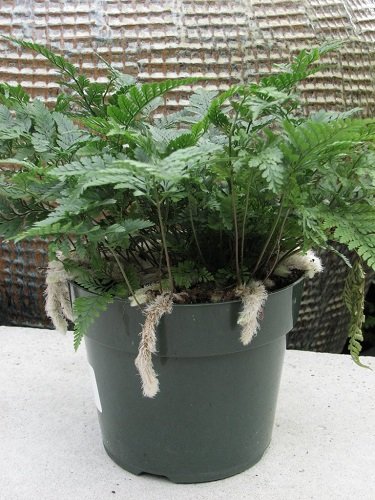
My hope for this thread is that we won't be biting off more than we can chew. I say "we" because this broad topic really needs the collective experiences from everyone who has delved into this area themselves and come to some conclusions on the matter. It is definitely subjective. I also don't want this to turn into a place to trash talk specific plants, but if you have picked up on the theme, then you already know there is favor given here to plants that are more easily maintained and work with the intended design. Creeping fig can work with any design, but unless the design is for a carpet of fig, some religious trimming is going to be required. Saying, "gosh, that plant sucks", doesn't really bring much to the table. Most plants are neat, but some types work better for the design (whatever yours is) than others, hence the existence of this thread. If you've ever wanted to get all philosophical (not debate) about plant selection, this would be a great time to jump in.
Again, this is a simple beginning, laying the foundation for more in-depth conversations about how we can use the various growth habit types and so on. If its already time to kick it up a notch, that's fine with me.
Mike



/clidemia_hirta12_(SB).jpg)

